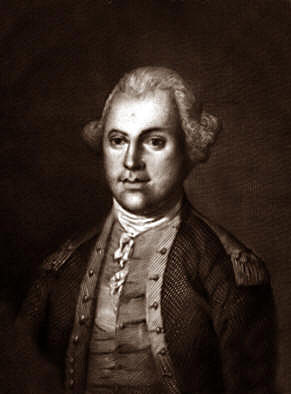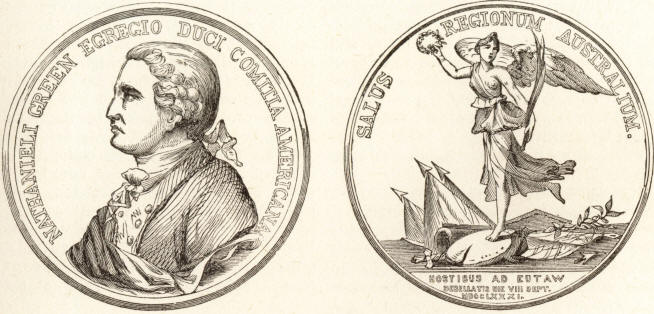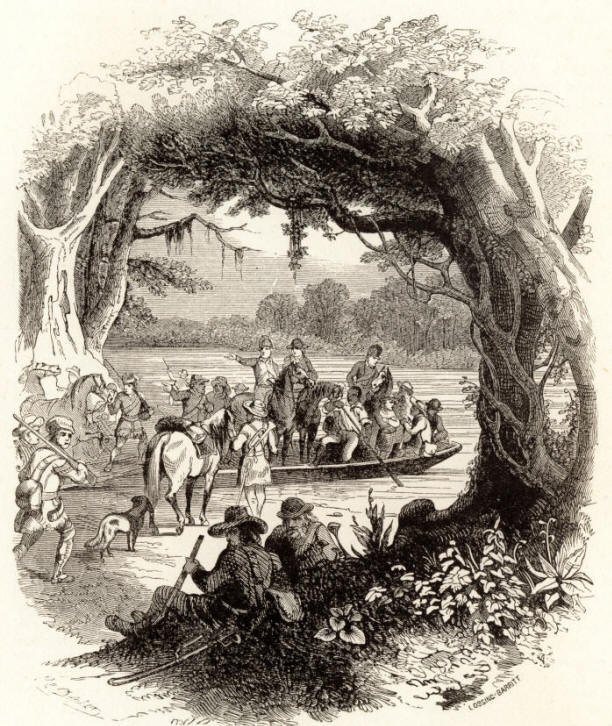General Nathanael Greene
|
|
This Site:
|
Expelling the British from the Southern country, Greene returned to Rhode Island at the close of the war. Congress presented him with two pieces of artillery. The State of Georgia gave him a fine plantation a few miles from Savannah, where he settled in the fall of 1785, and died June 19, 1786. South Carolina also gave him a valuable tract of land. A monument dedicated jointly to Greene and Pulaski stands in the city of Savannah, and the State of Rhode Island has erected an equestrian statue of him at the national capital, executed by H. K. Browne. The doubt that had long existed as to the actual burial-place of the hero was settled early in March, 1901, when Colonel Asa Bird Gardiner, acting in behalf of the Rhode Island Society of the Cincinnati, made an exploration of the cemeteries in Savannah, Georgia, and, in the Jones vault of the long-abandoned colonial cemetery, found the plate that had been on General Greene's coffin and three metal buttons, with the American eagle on them, doubtless from the uniform in which it is known that General Greene was buried. Greene's Southern CampaignWhile Greene and his army remained on the Santee Hills until late in the fall, his partisan corps, led by Marion, Sumter, Lee, and others, were driving the British forces from post to post, in the low country, and smiting Tory bands in every direction. The British finally evacuated all their interior stations and retired to Charleston, pursued almost to the edge of the city by the partisan troops. The main army occupied a position between that city and Jacksonboro, where the South Carolina legislature had resumed its sessions. Greene had failed to win victories in battle, but had fully accomplished the object of his campaign—namely, to liberate the Carolinas and Georgia from British rule. In the course of nine months he had recovered the three Southern States, and at the close of 1781 he had all the British troops below Virginia hemmed within the cities of Charleston and Savannah. Greene's Retreat Across North CarolinaAfter the disaster at the Cowpens, Cornwallis placed his force in light marching order and started in pursuit of Morgan, hoping to intercept him before he could cross the Catawba River. The earl ordered all his stores and superfluous baggage to be burned, and his whole army was converted into light infantry corps. The only wagons saved were those with hospital stores, salt, and ammunition, and four empty ones for sick and wounded. Sensible of his danger, Morgan, leaving seventy of his wounded under a flag of truce, crossed the Broad River immediately after the battle at the COWPENS, and pushed for the Catawba. Cornwallis followed the next morning. Two hours before the van of the pursuers appeared, Morgan had passed the Catawba at Trading Ford, and before the British could begin the passage, heavy rains produced a sudden rise in the waters, and time was given to Morgan to send off his prisoners, and to refresh his weary troops. When Greene heard of the affair at the Cowpens, he put his troops in motion to join Morgan. Pressing forward with only a small guard, he joined Morgan two days after he had passed the Catawba (January 29, 1781), and assumed, in person, the command of the division. And now one of the most remarkable military movements on record occurred. It was the retreat of the American army, under Greene, from the Catawba through North Carolina into Virginia. When the waters of the Catawba subsided, Cornwallis crossed and resumed his pursuit. He reached the right bank of the Yadkin (Feb. 3), just as the Americans were safely landed on the opposite shore. Again he was arrested by the sudden swelling of the river. Onward the flying patriots sped, and after a few hours Cornwallis was again in full pursuit. At Guilford Courthouse Greene was joined (February 7) by his main army from Cheraw, and all continued their flight towards Virginia, for they were not strong enough to give battle. After many hardships and narrow escapes, the Americans reached the Dan (February 15, 1781), and crossed its rising waters into the friendly bosom of Halifax county, Virginia. When Cornwallis arrived, a few hours afterwards, the stream was so high and turbulent that he could not cross. There, mortified and disappointed, the earl abandoned the chase, and, moving sullenly southward through North Carolina, established his camp at Hillsboro.
General Greene Crossing the Dan River |
|
|
||
|
|
Site Copyright 2003-2018 Son of the South. For Questions or comments about this collection, contact: paul@sonofthesouth.net |
|
|
Are you Scared and Confused? Read My Snake Story, a story of hope and encouragement, to help you face your fears. |
||
 Greene,
NATHANAEL, military officer; born in Warwick,
Greene,
NATHANAEL, military officer; born in Warwick,

